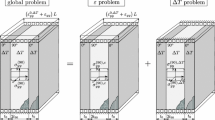Summary
Cross-ply laminates with transverse plies containing through-width matrix cracks across the thickness of the transverse plies are studied using an energy-based approach,complementary to that of Hashin. An upper bound on the effective axial stiffness of the cracked laminates with a uniform distribution of transverse cracks is derived. The equations governing the field variables in a typical RVE are derived using thelayerwise laminate theory of Reddy and are solved using the finite element method. The predicted reduction in the effective axial modulus is in good agreement with experimental results, and it approaches a fixed value with increase in crack density for laminates with bothstaggered andnon-staggered cracking. Laminates with staggered cracks showed a greater reduction in effective modulus at lower crack densities. The stress distribution and mechanics of load transfer is examined in detail, at two crack densities including the characteristic damage state. The crack opening profile has been normalized in a special way in terms of the crack density, layup parameters and material properties.
Similar content being viewed by others
References
Garrett, K. W., Bailey, J. E.: Multiple transverse fracture in 900 cross-ply laminates of glass fibrereinforced polyester. J. Mater. Sci.12, 157–168 (1977).
Highsmith, A. L., Reifsnider, K. L.: Stiffness reduction mechanisms in composite laminates. Damage in Composite Materials, ASTM STP775, (Reifsnider, K. L., ed.), pp. 103–117. American Society for Testing and Materials 1982.
Flaggs, D. L.: Prediction of tensile matrix failure in composite laminates. J. Comp. Mater.19, 29–50 (1985).
Norman, L., Dvorak, G. J.: Progressive transverse cracking in composite laminates. J. Comp. Mater.22, 900–916 (1988).
Han, Y. M., Hahn, H. T., Croman, R. B.: A simplified analysis of transverse ply cracking in crossply laminates. Comp. Sci. Technol.31, 165–177 (1988).
Lim, S. G., Hong, C. S.: Prediction of transverse cracking and stiffness reduction in cross-ply laminated composites. J. Comp. Mater.23, 695–713 (1989).
Zhang, J., Fan, J., Soutis, C.: Analysis of multiple matrix cracking in [±θ m /90 n ] s composite laminates. Part 1: In-plane stiffness properties. Composites23, 291–298 (1992).
Zhang, J., Fan, J., Soutis, C.: Analysis of multiple matrix cracking in [±θ m /90 n ] s composite laminates. Part 2: Development of transverse ply cracks. Composites23, 299–304 (1992).
Lee, J. H., Hong, C. S.: Refined two-dimensional analysis of cross-ply laminates with transverse cracks based on the assumed crack opening displacement. Comp. Sci. Technol.46, 157–166 (1992).
Hashin, Z.: Analysis of cracked laminates: A variational approach. Mech. Mater.4, 121–136 (1985).
Herakovich, C. T., Aboudi, J., Lee, S. W., Strauss, E. A.: Damage in composite laminates: effects of transverse cracks. Mech. Mater.7, 91–107 (1988).
Gudmundson, P., Ostlund, S.: First order analysis of stiffness reduction due to matrix cracking. J. Comp. Mater.26, 1009–1030 (1992).
Gudmundson, P., Zang, W.: An analytical model for thermoelastic properties of composite laminates containing transverse matrix cracks. Int. J. Solids Struct.30, 3211–3231 (1993).
Gudmundson, P., Ostlund, S.: Numerical verification of a procedure for calculation of elastic constants in microcracking composite laminates. J. Comp. Mater.26, 2480–2492 (1992).
Nairn, J. A.: The strain energy release rate of composite microcracking: a variational approach. J. Comp. Mater.23, 1106–1129 (1989).
Varna, J., Berglund, L. A.: Multiple transverse cracking and stiffness reduction in cross-ply laminates. J. Comp. Technol. Res.13, 99–106 (1991).
Varna, J., Berglund, L. A.: A model for prediction of the transverse cracking strain in cross-ply laminates. J. Reinforced Plastics Comp.11, 708–728 (1992).
McCartney, L. N.: Theory of stress transfer in a 00-900-00 cross-ply laminate containing a parallel array of transverse cracks. J. Mech. Phys. Solids40, 27–68 (1992).
Talreja, R.: Stiffness properties of composite laminates with matrix cracking and interior delamination. Eng. Fracture Mech.25, 751–762 (1986).
Allen, D. H., Harris, C. E., Groves, S. E.: A thermomechanical constitutive theory for elastic composites with distributed damage—I. Theoretical development. Int. J. Solids Struct.23, 1301–1318 (1987).
Lee, J. W., Allen, D. H., Harris, C. E.: Internal state variable approach for predicting stiffness reductions in fibrous laminated composites with matrix cracks. J. Comp. Mater.23, 1273–1291 (1989).
Reddy, J. N.: A generalization of the two-dimensional theories of laminated composite plates. Comm. Appl. Numer. Methods3, 173–180 (1987).
Robbins, Jr., D. H., Reddy, J. N.: Modelling of thick composites using a layerwise laminate theory. Int. J. Numer. Methods Eng.36, 655–677 (1993).
Barbero, E. J., Reddy, J. N.: Modeling of delamination in composite laminates using a layer-wise plate theory. Int. J. Solids Struct.28, 373–388 (1991).
Reddy, J. N., Robbins, Jr., D. H.: Theories and computational models for composite laminates. Appl. Mech. Rev.47, 147–169 (1994).
Reddy, J. N.: Introduction to the finite element method, 2nd ed. New York: McGraw Hill 1993.
Nuismer, R. J., Tan, S. C.: Constitutive relations of a cracked composite lamina. J. Comp. Mater.22, 306–321 (1988).
Gamby, D., Rebière, J. L.: A two-dimensional analysis of multiple matrix cracking in a laminated composite close to its characteristic damage state. Comp. Struct.25, 325–337 (1993).
Varna, J., Berglund, L. A., Talreja, R., Jakovics, A.: A study of the opening displacement of cracks in cross-ply laminates. Int. J. Damage Mech.2, 272–289 (1993).
Motogi, S., Fukuda, T., Fushimi, T.: Matrix crack opening displacement in cross-ply composite laminates. In: Advances in fiber composite materials, Vol. 12 (Fukuda, T., Maekawa, Z., Fuji, T., eds.), pp. 25–39. The Society for Materials Science, Japan, 1995.
Dvorak, G. J., Laws, N., Hejazi, M.: Analysis of progressive matrix cracking in composite laminates I. Thermoelastic properties of a ply with cracks. J. Comp. Mater.19, 216–234 (1985).
Hughes, T. J. R.: The finite element method. Englewood Cliffs: Prentice-Hall, 1987.
Author information
Authors and Affiliations
Rights and permissions
About this article
Cite this article
Praveen, G.N., Reddy, J.N. Transverse matrix cracks in cross-ply laminates: Stress transfer, stiffness reduction and crack opening profiles. Acta Mechanica 130, 227–248 (1998). https://doi.org/10.1007/BF01184313
Received:
Revised:
Issue Date:
DOI: https://doi.org/10.1007/BF01184313




